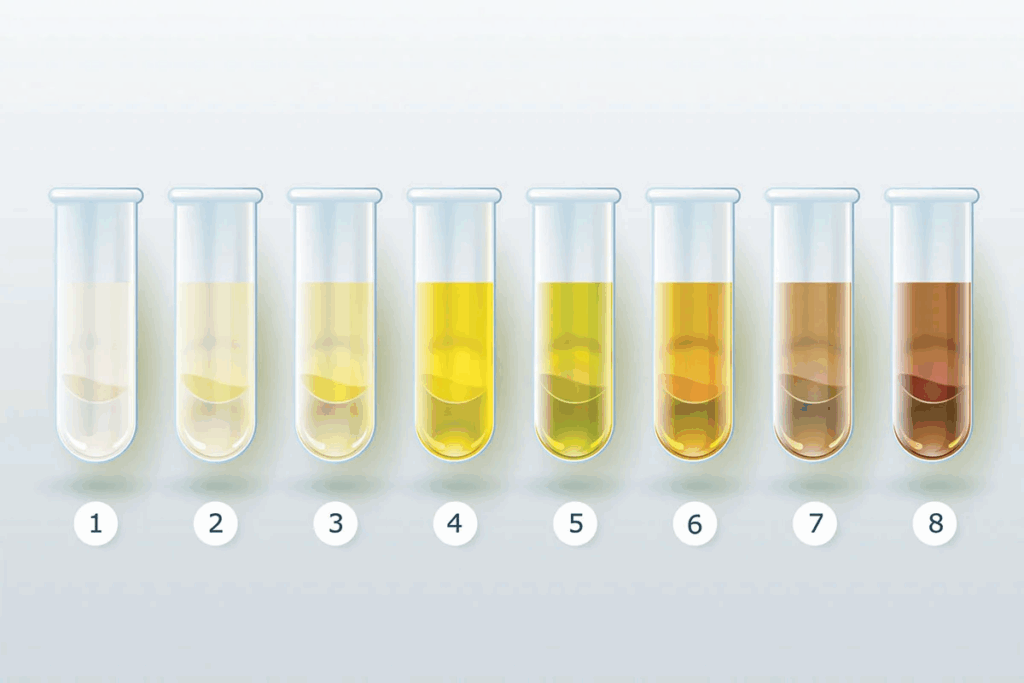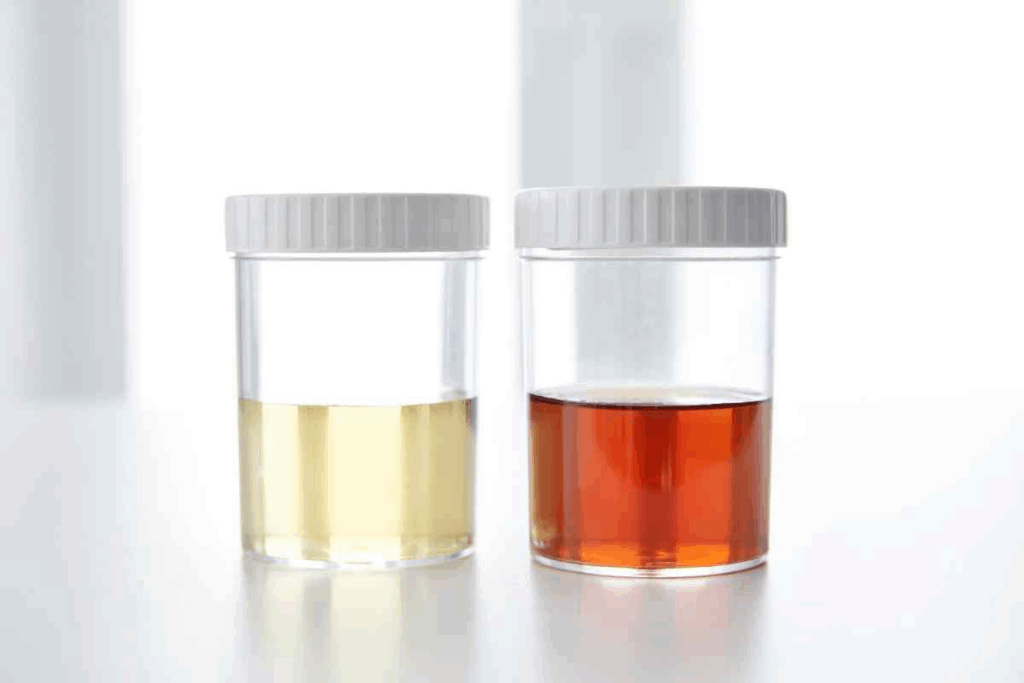Last Updated on October 31, 2025 by

Our bodies send important messages, and light pink urine color is a key way they do it.
When urine color changes, it can mean a few things. It might show how well we’re hydrated or what we’ve eaten. For example, colored urine can go from clear to deep amber, depending on our water intake and diet.
Knowing what different pee colors mean helps us keep an eye on our health. At Liv Hospital, we offer expert advice and care. We help you understand your body’s signals.

Urine color tells us a lot about our health. It’s shaped by many body processes. Knowing these can help us understand what different colors mean.
Our kidneys are key in making urine. They filter out waste and extra water from our blood. This job is done by nephrons, the kidneys’ tiny units.
Every day, the kidneys filter about 200 liters of blood. This leads to 1-2 liters of urine, depending on how much we drink and other factors.
Urochrome, or urobilin, is what makes urine yellow. It comes from breaking down hemoglobin in red blood cells. The kidneys put urochrome into the urine.
The shade of yellow can change. If we’re not drinking enough water, our urine gets darker. This can be yellow or amber.
How concentrated urine is also matters. When we drink a lot of water, our urine is light yellow or clear. But if we’re not drinking enough, it gets darker.
Here’s a table showing how hydration affects urine color:
| Hydration Level | Urine Color | Interpretation |
| Well-hydrated | Pale yellow or clear | Normal, indicates good hydration |
| Mildly dehydrated | Dark yellow | May indicate slight dehydration |
| Dehydrated | Amber or dark amber | Indicates significant dehydration |
Knowing about urine color helps us see its importance. By noticing changes, we can spot health problems early.

The color of our urine tells us a lot about our hydration and health. Different urine colors show different things about our well-being. Knowing these colors can help us spot health problems early.
Straw-colored urine is the best color, showing we’re well-hydrated and our kidneys are working right. When our urine is straw-colored, it means we’re drinking enough water and our kidneys are doing their job.
Pale yellow urine means we’re drinking enough water. Good hydration is key for our health. It helps keep our body temperature right, moves nutrients, and gets rid of waste.
Transparent or clear urine might mean we’re drinking too much water. While drinking water is good, too much can upset our electrolyte balance. It’s important to find the right amount of water for our health.
| Urine Color | Indication |
| Straw-Colored | Ideal hydration and kidney function |
| Pale Yellow | Good hydration levels |
| Transparent/Clear | Possible overhydration |
Seeing amber or dark yellow urine often means you’re dehydrated. Dehydration happens when we lose more fluids than we take in. This imbalance makes our urine darker.
Amber urine tells us our body needs more water. Several things can cause dehydration, like:
Not drinking enough water makes our kidneys work harder. This leads to darker, more concentrated urine. It’s key to drink water all day to stay hydrated.
Long-term dehydration can harm our health. Some risks include:
Spotting dehydration early can stop these problems. If your urine is always dark yellow or amber, check how much water you drink.
Getting hydrated is easy: just drink more water. But, how much you need depends on your age, sex, weight, and how active you are. Here are some tips to stay hydrated:
By focusing on hydration, you can keep your health in check and avoid dehydration problems.
Light pink urine can mean different things. It could be from what you eat or a health issue. We’ll look into what might be causing it and when you should worry.
Hematuria is when you have blood in your urine. It can happen due to infections, stones, or even cancer in the bladder or kidneys.
Some foods can make your urine look pink or red. Beets, berries, and rhubarb are examples. If you’ve eaten these, they might be why your urine looks different.
If your urine stays pink or you have pain, you should see a doctor. Also, if you’re going to the bathroom a lot or have belly pain. A doctor can check if there’s something serious going on.
| Cause | Symptoms to Watch | Action |
| Dietary Influence | No other symptoms, color change is temporary | No action needed, observe |
| Urinary Tract Infection | Pain while urinating, frequent urination | Seek medical attention |
| Kidney Stones or Cancer | Abdominal pain, persistent hematuria | Immediate medical consultation |
Keep an eye on your urine color. It can tell you a lot about your health. If you see anything strange, talk to a doctor.
Seeing red or dark red urine can signal health issues like infections and cancers. It’s scary, but knowing the reasons and getting medical help is key.
Red urine, or hematuria, points to serious problems. These include urinary tract infections, kidney stones, and cancer like bladder or kidney cancer. It can also mean injury or inflammation in the urinary tract.
Finding out why urine is red is vital for the right treatment. We’ll look at tests for diagnosing red urine later.
Not every red or dark red urine is a sign of a serious issue. Some foods and medications can make urine look red or pink. Eating beets or rhubarb, or taking certain antibiotics or laxatives, can do this.
Healthcare providers use tests to figure out why urine is red. They might do:
These tests help find the cause of red urine. They guide the right treatment and care.
Seeing orange urine can worry you, but knowing why it happens can ease your mind. Orange urine can come from different things like health issues, medicines, and what you eat.
Several health problems can make urine look orange or dark orange. A big reason is dehydration, which makes urine more concentrated and changes its color. Other health issues that might make urine orange include:
If you keep seeing changes in your urine color, it’s smart to talk to a doctor, even if you’re not feeling sick.
Some medicines can turn urine orange or dark orange. Here are a few examples:
If you’re taking medicine and notice your urine is different, talk to your doctor. They can check if it’s okay.
What you eat can also change your urine color. Eating foods or taking supplements with certain compounds can make urine orange. For instance:
Even though diet changes are usually safe, knowing about them can help you figure out why your urine is orange.
Urine that looks brown or tea-colored can signal serious health issues. These include liver disease and muscle damage. It’s important to seek medical help quickly to avoid more problems.
Liver disease often causes urine to turn brown or tea-colored. This happens when the liver can’t process bilirubin properly. Diseases like hepatitis and cirrhosis can lead to this.
Key symptoms of liver disease include:
Rhabdomyolysis is a serious condition where muscle tissue breaks down. This releases myoglobin into the blood, which turns urine dark brown or tea-colored. It can be caused by intense exercise, trauma, or some medications.
Common causes of rhabdomyolysis include:
Other things can also make urine dark brown. These include severe dehydration, certain foods or medications, and other health issues.
Other possible causes include:
If your urine is often dark brown or tea-colored, see a doctor. They can find out why and help you get better.
Unusual urine colors like blue, green, and purple can come from many things. This includes medicines and health issues. Knowing why these colors happen can help you understand and, if needed, get medical help.
Some rare health problems and genetic issues can make urine colors strange. For example, blue diaper syndrome is a genetic problem. It makes urine turn blue when it meets air because of a trouble with absorbing tryptophan.
Porphyria can make urine look purple or reddish-brown. This happens because of problems with making heme.
Some medicines and dyes can change urine color. For example:
Bacterial infections can also cause strange urine colors. For instance, a UTI caused by Pseudomonas aeruginosa can make urine green or blue-green. This is because the bacteria produce a pigment.
It’s important to know why urine colors change. If you see lasting or odd changes in your urine, see a doctor. They can help figure out what’s going on and what to do next.
Watching your urine color is a simple way to check if you’re hydrated and spot health problems early. We’ve looked at the different colors urine can be and what they might mean for your health.
Knowing what affects urine color helps you take action if you notice something off. By keeping an eye on your urine and listening to your body, you can catch and treat problems early. This includes everything from dehydration to serious diseases.
We suggest making it a habit to check your urine color every day. Doing this, along with a healthy lifestyle and regular doctor visits, can really help your health. Paying attention to changes in your urine can be a key way to keep an eye on your health.
Being proactive and informed can help you use urine color monitoring to improve your health. Catching problems early is a big step towards being healthier.
The color of your urine can tell you about your hydration, diet, and health. Normal urine is straw-colored to pale yellow. But, unusual colors might mean you have a health problem.
Healthy urine is straw-colored or pale yellow. This shows you’re well-hydrated and your kidneys are working right.
Dark yellow or amber urine means you’re dehydrated. You need to drink more water to stay healthy and avoid dehydration problems.
Light pink urine can come from many things, like health issues or what you eat. Foods like beets or berries can make your urine pink or red.
Red or dark red urine might mean you have a serious health problem. This could be a urinary tract infection, kidney stones, or even cancer. Some foods or meds can also cause it, but if it keeps happening, see a doctor.
Orange or dark orange urine can be from health issues, meds, or food. Knowing what can change your urine color helps you spot health problems.
Brown or tea-colored urine is a sign of serious health issues. This could be liver disease or muscle breakdown. You should see a doctor right away.
Yes, some foods and meds can change your urine color. Beets or berries can make it pink or red. Certain meds can make it orange or other colors.
If your urine looks different, watch it for a while. If it doesn’t go back to normal, get medical help. Knowing why your urine color changes can help you stay healthy.
Watching your urine color is a good way to stay healthy. Knowing what colors mean can help you catch health problems early. And, it tells you when to see a doctor
Subscribe to our e-newsletter to stay informed about the latest innovations in the world of health and exclusive offers!